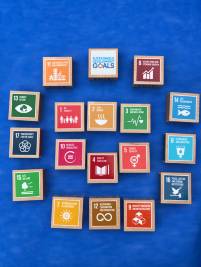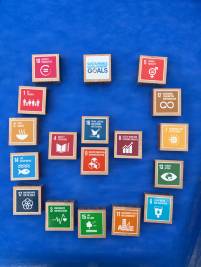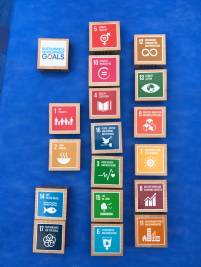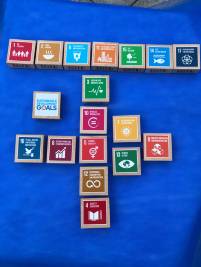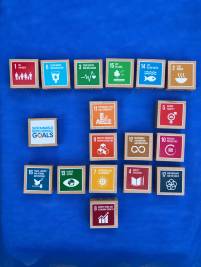Interactions and interdependencies between the SDGs
The SDGs never act one dimensionally. Each can strengthen the effects of others, in fact even make their effects possible. A few examples of the way that this interrelated action can work well will be shown here. The „BiWiNa SDG-blocks“ should be organized as the participants think they go together, or how the best synergy between them can be achieved.
The examples presented here are only suggestions, and should serve to stimulate discussion about the meaning of the SDGs as drivers to promote social transformation.
Example 1: Education A
It is current opinion that education is key to work fit for humans and social acceptance. Thus the SDG 4 (Quality Education) is crucial. But it can be the case that a well-educated person cannot practice the occupation they learned, as they live in a society where particular groups are discriminated against. This discrimination can be on the grounds of family background, gender, skin color, religion, sexual orientation or being in a lower social class. So that SDG 4 can show its effects, it must interrelate with SDG 5 (Gender Equality) and SDG 10 (Reduced Inequalities). This is also the case for SDG 3 (Good Health and Well-being), SDG 2 (Zero Hunger), and SDG 9 (Industry, Innovation and Infrastructure).
In the center of picture 1, SDG 4 is flanked by SDG 10 and SDG 5. The SDGs 1, SDG 2 and SDG 3 have been placed above, as conditions useful for successful education. The workshop participants should work out if and how the other SDGs also influence education.
Picture 1. Arranging the SDGs for Example 1: Education A
Example 2: Education B
If education is recognized as essential, the question is, what is necessary to provide for the required „Quality Education“ (SDG 4)?
For a good education, it is necessary to have a system that includes the appropriate educational institutions, educational programs, well-trained teachers and last but not least and appropriate physical infrastructure in which instruction can take place. SDG 16 (Peace, Justice and Strong Institutions) addresses state institutions. The SDG 4 includes the education of teachers and instructors, as well as grade school and college students. Adequate buildings definitely require solid and sustainable financing. These come from the taxes paid by businesses and citizens. A precondition for this is a well functioning economy with „Decent Work and Economic Growth“ (SDG 8). The state is responsible for implementing a fair and efficient system of taxation (SDG 16).
Picture 2. Arranging the SDGs for Example 2: Education B
Example 3: Poverty and Hunger
The first two SDGs are „No Poverty“ (SDG 1) and „Zero Hunger“ (SDG 2).
How can this be achieved?
The permanent eradication of poverty and hunger is a very complex challenge.
The main reason for poverty and hunger is often lack of an adequate income. There are different reasons for this. One can be that there is little paid work available. But it can also be that the income is inadequate to support a humane existence. In a market economy, the private sector and to a lesser extent the state are responsible for the creation of jobs. Here the SDG 8 (Decent Work and Economic Growth) plays an important role. But for the economy to develop, several factors must function at the same time. Important conditions are along with adequate basic conditions (SDG 16, Peace, Justice and Strong Institutions) is a good functioning economy (SDG 8) and an appropriate infrastructure (SDG 9, Industry, Innovation and Infrastructure). Combatting poverty requires the reduction of discrimination and inequality.
For the fight against poverty, it is important that people's health is not endangered.
The following elements are essential: the development of a health and social security system (SDG 3, Good Health and Well-being) together with the prevention of environmental pollution (SDG 6, Clean Water and Sanitation and SDG 15, Life on Land), and the creation of a network for supplying drinking water with the corresponding sewage and water treatment systems (SDG 6). So that these systems can be installed, communities must have a certain degree of organization (SDG 11).
Back to the workplaces: Here SDG 9 (Industry, Innovation and Infrastructure) is involved. The appropriate technologies must also be available, and sustainable means of production must be established (SDG 12, Responsible Consumption and Production). This is represented by SDG 9. Clean energy in adequate amounts and at affordable prices is also an important factor for economic development. Here again we see SDG 7 (Affordable and Clean Energy) and SDG 13 (Climate Action).
The participants should organize the rest of the SDG around Poverty and Hunger.
Picture 3. Organizing the SDG for Example 3, Poverty and Hunger
Example 4: Growth
In today's economic system, growth is a major factor in the creation of jobs and prosperity. But we should not forget that in many cases, growth in our current system comes with costs for nature and people.
The SDG 8 (Decent Work and Economic Growth) represents the relationship between the quality of work and growth. In today's realities this relationship does not have to be a positive one. Here we must ask two questions. The first has to do with the conditions necessary so that the work is humane, and the second has to do with the concept of growth itself. How can growth happen without environmental harm? Or is growth even definitely necessary?
For work to be humane, several SDGs must be active together. First SDG 16 (Peace, Justice and Strong Institutions) is critical. This determines the basic conditions, and SDG 3 (Good Health and Well-being) and SDG 5 (Gender Equality) are likewise important features of a humane workplace. This workplace should not cause any environmental pollution (SDG 14, Life Below Water and SDG 15, Life on Land).
With economic growth comes the question of how it should be achieved. How should non-renewable resources be handled? And what kind of energy should drive growth? Here the SDG 7 (Affordable and Clean Energy) is very important. And SDG 9 (Industry, Innovation and Infrastructure) plays a major role, above all when it comes to innovation. New technologies for more frugal use of resources and substitution of nonrenewable resources through renewable ones could make a major contribution to relieving environmental degradation. SDG 12 (Responsible Consumption and Production) is also important here. The criteria of sustainability should be considered by all sides, consumers as well as producers. In the transformational process, education and training (SDG 4, Quality Education) play important roles will in preparing the population, management and the workforce for new challenges. Training and education should also help create the required awareness.
The rest of the SDGs can be found at the top of the picture, and should be organized by the participants around growth.
Picture 4. Organizing the SDGs for Example 4, Growth
Example 5: Climate Protection
Protecting the climate is one of the biggest challenges of our time. Because climate protection is a very complex task, it must be considered from various angles.
On one side there are political aspects, and on the other, the more technical solutions. SDG 16 (Peace, Justice and Strong Institutions) stands for peace and justice. In the targets, state institutions are mentioned, because without their action climate protection is impossible. One of the most important causes for the increase in CO2 in the atmosphere is combustion of fossil fuels. Changing energy production to renewable sources of energy (SDG 7, Affordable and Clean Energy) is an important for lowering CO2 emissions. The power supply in all countries on earth is more or less regulated by the state, thus a major transition to renewables can only happen when decided upon at the responsible levels. And thus SDG 16 is again in play. When there is a transition in energy supply, existing power lines must be able to transport the electricity from the point of production to consumers. Conventional power plants are often located close to consumers. But wind, sun, geothermal and wave power are not located near consumers, for easy local use. Here we need to consider SDG 9 „Industry, Innovation and Infrastructure“.
A society that has decided to pursue renewable energy as its major source of energy production urgently needs new industries and jobs (SDG 8, Decent Work and Economic Growth). This path involves a different type of economy with lower, and later completely without, CO2 emissions.
Cities and communities (SDG 11, Sustainable Cities and Communities) play an important role in climate protection. This is where people live, thus residential communities must be redesigned to use less energy. Here, for example, transportation and private home energy use need to be included.
Social acceptance for renewables and the related changes in the economy and society must be secured. Here education and public awareness are crucial (SDG 4). But „Responsible Consumption“ (SDG 12) must also contribute to sustainability.
Social aspects play a large role in connection with climate protection, which is an inclusive challenge. The question of gender (SDG 5, Gender Equality) as well as the reduction of inequality inside and between states and regions (SDG 10, Reduced Inequalities) play important roles here because of the access to appropriate technologies. Without the participation of women (SDG 5, Gender Equality), the process of transforming society and the economy cannot succeed. Women make major contributions to the economy and families. Reducing inequality in and between the states and regions (SDG 10) is also essential. Renewable energy can come from regions located far from the centers of production, where people often live in disadvantaged conditions. The use of renewables must also benefit them.
Successful models for organizing society and economy as well as modern technologies should be discussed internationally, with the goal of investigating how these can also be successfully established in other countries. International cooperation is essential when it comes to climate protection (SDG 17, Partnerships for the Goals).
The rest of the SDGs can be found in the upper part of the picture, and should be arranged by participants to maximize climate protection.
Picture 5. Organization of the SDGs for Example 5, Climate Protection
Example 6: Supply chain
A result of globalization is the "extension" of the supply chain. When production moves abroad and many suppliers are involved in producing very different products, the end consumer often does not know where a product just purchased was produced, or the ecological and social conditions under which this took place.
The corresponding picture for that (picture 6) is constructed on six levels. In the three bottom ones are SDG 12 (Responsible Consumption and Production), framed between the basis for a fair distribution chain: SDG 16 (Peace, Justice and Strong Institutions), SDG 17 (Partnerships for the Goals) and SDG 4 (Qualitative Education), which are all important determining factors for the distribution chain. No discrimination of women in the workplace (SDG 5, Gender Equality) and „Reduced Inequalities“ (SDG 10) are requirements for humane work (SDG 8, Decent Work and Economic Growth). In the construction of buildings and infrastructure, worker safety must be assured (SDG 9, Industry, Innovation and Infrastructure).
Consumers (SDG 12) as well as producers (SDG 8, Decent Work and Economic Growth) bear responsibility in achieving SDG 12 (Responsible Consumption and Production). Domestically, conditions in the workplace, wages and obligations and rights of workers and employers are regulated by the state (SDG 16, Peace, Justice and Strong Institutions). In poorer countries these can be deficient. Social standards (SDG 5, Gender Equality and SDG 10, Reduced Inequalities) are not available or they are not observed, and the environment is strongly contaminated, with negative consequences for people (SDG 3, Good Health and Well-Being, SDG 6, Clean Water and Sanitation), water sources (SDG 14, Life Below Water) and land (SDG 15, Life on Land).
In many of these countries energy production is based on the burning of fossil fuels -- often with obsolete technology resulting in heavy environmental contamination, with exhaust fumes and particles as well as with high CO2 emissions. In many cases a conversion to environmentally friendly techniques is necessary, especially to renewable sources of energy. Solutions can be developed in partnership with the consumers of the products.
At the top of the picture are basic aspects, such as overcoming poverty (SDG 1, No Poverty), Hunger (SDG 2, Zero Hunger) and building Sustainable Cities and Communities (SDG 11).
Picture 6. Organizing the SDGs for Example 6, the Supply Chain
